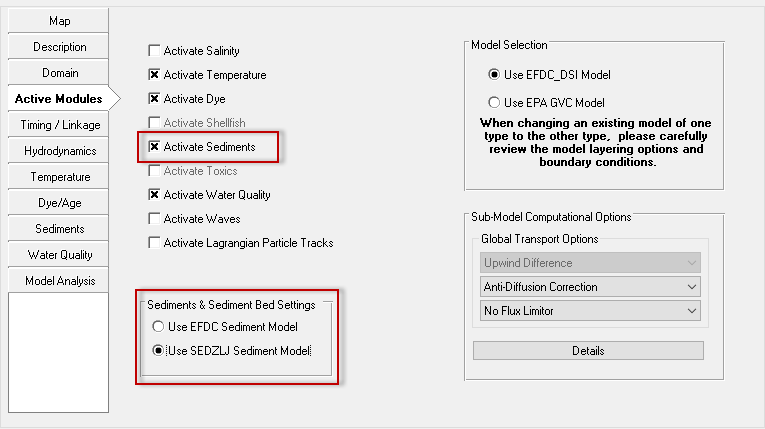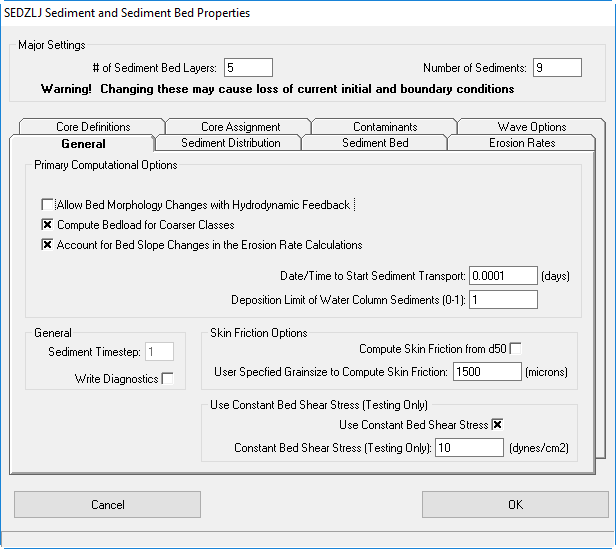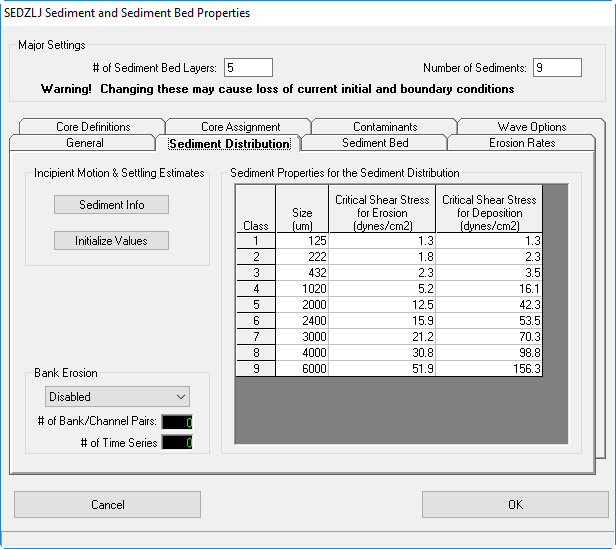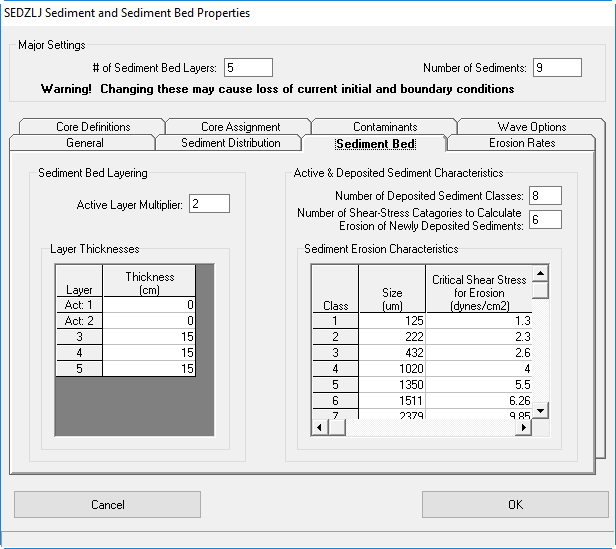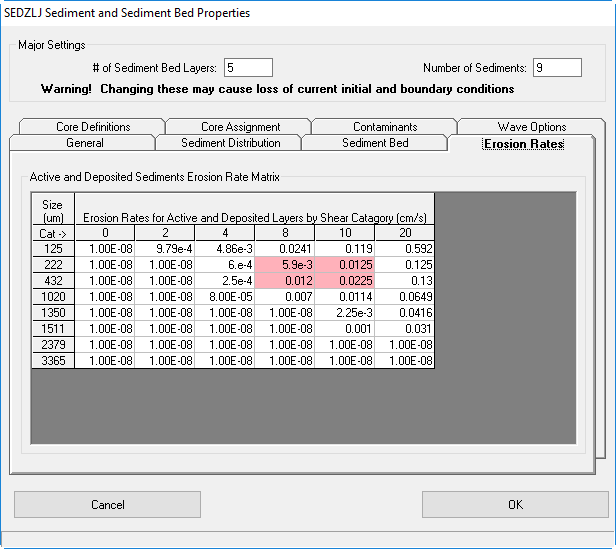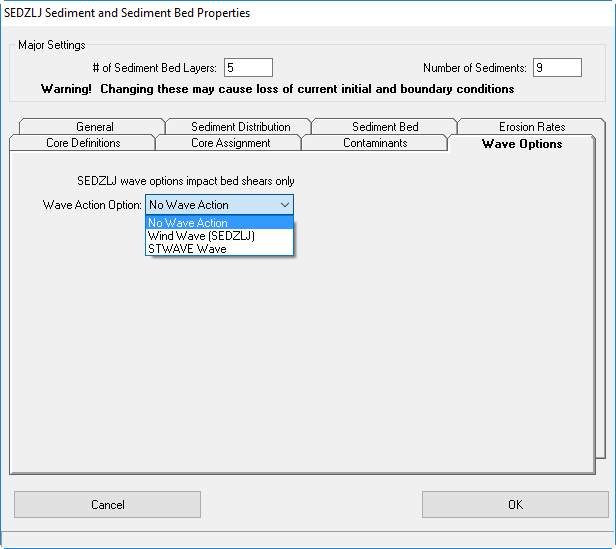...
Figure 2 Active Module tab - SEDZLJ sediment transport sub-model.
1.1 General Settings Tab
...
The Date/Time to Start Sediment Transport allows the user to run the model without erosion and deposition active until the model is stable. After model is stable, the sediment transport is fully activated from the specified time. The Deposition Limit of water Column Sediments is a value from 0 to 1. This represents the minimum fraction of sediment in the bottom water layer allowed to deposit in a single time step. Setting this to zero would cause 100% of the amount to be deposited in one time step, however, this is also dependent on the settling rate specified.
Figure 3 SEDZLJ sediment transport sub-model – General tab.
The user should refer to the SEDZLJ user manual for more information on Skin Friction Options and Use Constant Bed Shear Stress options.
...
In the Incipient Motion & Settling Estimates frame shown in Figure 4 there is a Sediment Info button which reports the critical shear stress for grain sizes used in the Sediment Properties for the Sediment Distribution table. These calculations for the critical shear stress are based on the equations from Van Rijn (Van Rijn, et al 1984) which use uniform grain size calculations and provided for the user’s information. These numbers do not have any impact in the actual model calculations. The Initialize Defaults button uses the values calculated here to provide initial values for the critical shear stresses for erosion and deposition, though the user would normally have measured data for these.
Figure 4 SEDZLJ sediment transport sub-model – Sediment Distribution tab.
1.3 Sediment Bed Tab
...
The Active & Deposited Sediment Characteristics frame allows the users to specify the Number of Deposited Sediment Classes, as well as the Number of Shear Stress Categories to Calculation Erosion of Newly Deposited Sediments. Note that SEDZLJ allows for a different number of sediment classes for the sediment distribution and erosion characteristics.
Figure 5 SEDZLJ sediment transport sub-model – Sediment Bed tab.
1.4 Erosion Rates Tab
The Erosion Rates tab provides the user with the Active and Deposited Sediments Erosion matrix as shown in Figure 5. Highlighted cells provide a warning to the user that the erosion rate is not increasing with the increasing shear category, or that erosion rates are not decreasing with the increasing grain size. This is simply a QC check for the user and EFDC+ will still run despite the inconsistent values that have been input.
Figure 6 SEDZLJ sediment transport sub-model – Erosion Rates tab.
1.5 Core Definitions Tab
...
For each layer in each core the user should set the critical shear stress and bulk density. The grain size distribution as a percentage also needs to be input in the first table. In the second table the user should input the initial bed erosion rates for each layer for each shear stress defined.
Figure 7 SEDZLJ sediment transport sub-model
...
– Core Definitions tab.
1.6 Core Assignments Tab
...
The Spatially Varying Core Assignment frame provides options for the user to set the appropriate cores to the rest of the model domain. The Use Nearest Neighbor Approach option uses an interpolation method to assign core numbers using the X, Y coordinates of the core.
Figure 8 SEDZLJ sediment transport sub-model – Core Assignment tab.
The Assign Core Numbers using Polygons with ID’s option is an ordered assignment based on the IDs in the P2D file. This file is begins with a single line header that is used as the ID of the polyline/polygon, which in this case is the core number. Next in this file comes the X, Y data to define the polygon. EE assigns the specified core number to the group of cells that lie inside the polygon. In some cases polygons may overlap, for example the user may make a polygon with core ID 4, which is inside that for core ID 2. In this case, core ID 4 will have precedence over core ID 2 and core ID 2 will not be used at all
...
If the standard SEDZLJ wind wave option is used then the EE wind wave option is not used. In this case the user must ensure they have all the correct files such as FETCH.INP refer to the SEDZLJ user guide for details on this format. Conversely, if the STWAVE option is selected then that correctly formatted STWAVE files are required.
Figure 9 SEDZLJ sediment transport sub-model – Wave Options tab.
